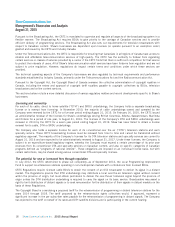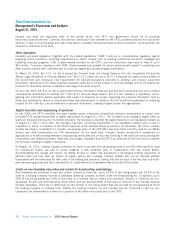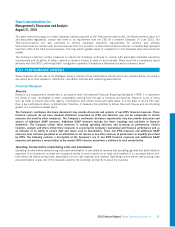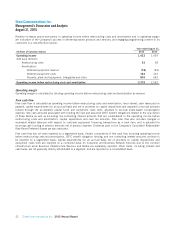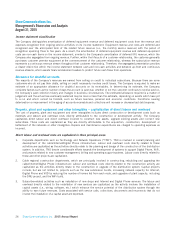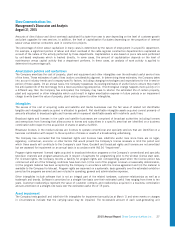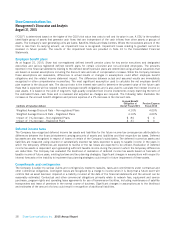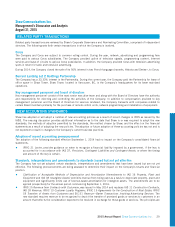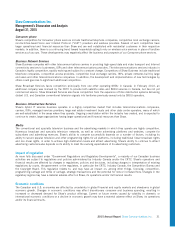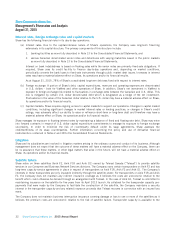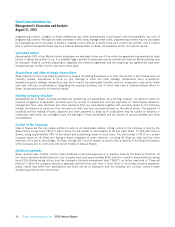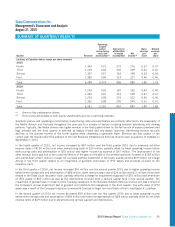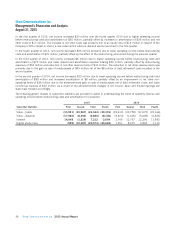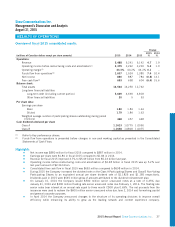Shaw 2015 Annual Report Download - page 30
Download and view the complete annual report
Please find page 30 of the 2015 Shaw annual report below. You can navigate through the pages in the report by either clicking on the pages listed below, or by using the keyword search tool below to find specific information within the annual report.
Shaw Communications Inc.
Management’s Discussion and Analysis
August 31, 2015
(“CGU”) is determined based on the higher of the CGU’s fair value less costs to sell and its value in use. A CGU is the smallest
identifiable group of assets that generate cash flows that are independent of the cash inflows from other assets or groups of
assets. The Company’s cash generating units are Cable, Satellite, Media and Data Centres. Where the recoverable amount of the
CGU is less than its carrying amount, an impairment loss is recognized. Impairment losses relating to goodwill cannot be
reversed in future periods. The results of the impairment tests are provided in Note 10 to the Consolidated Financial
Statements.
Employee benefit plans
As at August 31, 2015, Shaw had non-registered defined benefit pension plans for key senior executives and designated
executives and various registered defined benefit plans for certain unionized and non-unionized employees. The amounts
reported in the financial statements relating to the defined benefit pension plans are determined using actuarial valuations that
are based on several assumptions including the discount rate and rate of compensation increase. While the Company believes
these assumptions are reasonable, differences in actual results or changes in assumptions could affect employee benefit
obligations and the related income statement impact. The differences between actual and assumed results are immediately
recognized in other comprehensive income/loss. The most significant assumption used to calculate the net employee benefit
plan expense is the discount rate. The discount rate is the interest rate used to determine the present value of the future cash
flows that is expected will be needed to settle employee benefit obligations and is also used to calculate the interest income on
plan assets. It is based on the yield of long-term, high-quality corporate fixed income investments closely matching the term of
the estimated future cash flows and is reviewed and adjusted as changes are required. The following table illustrates the
increase on the accrued benefit obligation and pension expense of a 1% decrease in the discount rate:
(millions of Canadian dollars)
Accrued Benefit
Obligation at
End of Fiscal 2015
Pension Expense
Fiscal 2015
Weighted Average Discount Rate – Non-registered Plans 4.10% 4.00%
Weighted Average Discount Rate – Registered Plans 4.10% 4.09%
Impact of: 1% decrease – Non-registered Plans $ 84 $ 4
Impact of: 1% decrease – Registered Plans $ 31 $ 3
Deferred income taxes
The Company has recognized deferred income tax assets and liabilities for the future income tax consequences attributable to
differences between the financial statement carrying amounts of assets and liabilities and their respective tax bases. Deferred
tax assets are also recognized in respect of losses of certain of the Company’s subsidiaries. The deferred income tax assets and
liabilities are measured using enacted or substantially enacted tax rates expected to apply to taxable income in the years in
which the temporary differences are expected to reverse or the tax losses are expected to be utilized. Realization of deferred
income tax assets is dependent upon generating sufficient taxable income during the period in which the temporary differences
are deductible. The Company has evaluated the likelihood of realization of deferred income tax assets based on forecasts of
taxable income of future years, existing tax laws and tax planning strategies. Significant changes in assumptions with respect to
internal forecasts or the inability to implement tax planning strategies could result in future impairment of these assets.
Commitments and contingencies
The Company is subject to various claims and contingencies related to lawsuits, taxes and commitments under contractual and
other commercial obligations. Contingent losses are recognized by a charge to income when it is likely that a future event will
confirm that an asset has been impaired or a liability incurred at the date of the financial statements and the amount can be
reasonably estimated. Contractual and other commercial obligations primarily relate to network fees, equipment and service
purchases, program rights and operating lease agreements for use of transmission facilities, including maintenance of satellite
transponders and lease of premises in the normal course of business. Significant changes in assumptions as to the likelihood
and estimates of the amount of a loss could result in recognition of additional liabilities.
28 Shaw Communications Inc. 2015 Annual Report


